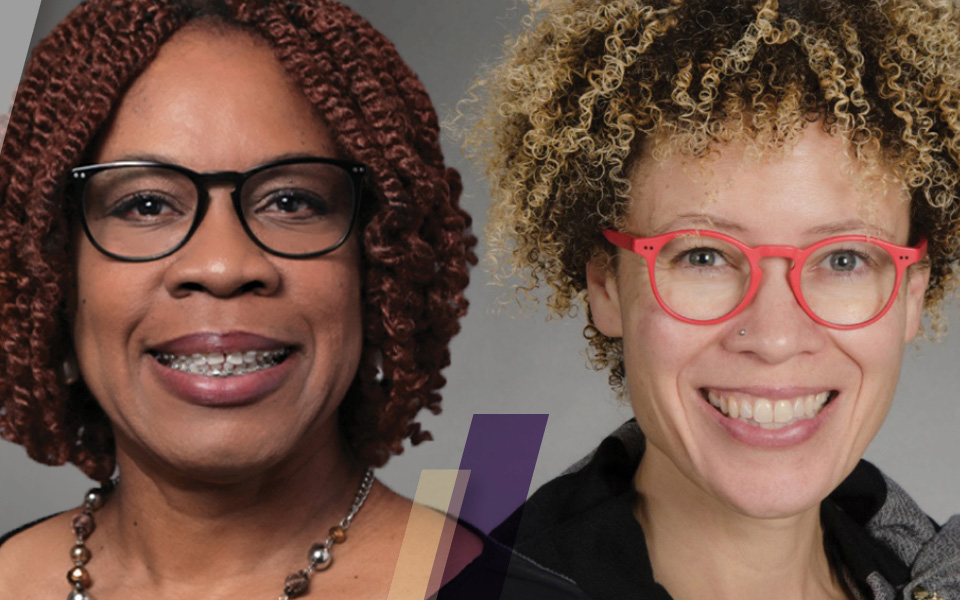
From the Podcast: Racism Is a Public Health Crisis
“Racism is a stressor that causes wounds to the individuals who are exposed to it,” says Sharon Laing. Listen to Laing and Wendy Barrington in a two-part podcast from Paw’d Defiance.
Racism is a public health crisis, says UW Tacoma Assistant Professor Sharon Laing. In July, Laing and UW Associate Professor Wendy Barrington were guests on the campus podcast, Paw’d Defiance, to talk about the social determinants of health (SDOH). “The World Health Organization describes social determinants of health as ‘the conditions in which people are born, grow, live, work and age,’” said Barrington. “Examples include social and built environments, economic and educational opportunities and access to healthcare.”
Laing and Barrington research how factors like race and racism relate to health outcomes. “We know that with many African Americans, the problem when addressing health outcomes is not that we are getting diseases more frequently than other groups,” said Laing. “Rather, what this is all about is that when we do get a disease, that disease tends to progress to a more severe form because of not having the resources to take care of this condition when it first occurs,” said Laing.
Maybe the next obvious question is, why? Why do members of this community lack resources? “We have at the systemic or structural level, policies and practices and norms that are not affecting people equally,” said Barrington.
These policies, practices, and norms dictate who can live where, who has access to education, and the level of healthcare people receive. “Bias in our healthcare system disproportionately affects communities of color which leads to disparities in health outcomes,” said Laing.
Laing and Barrington describe a kind of disease, one that has spread for centuries, and may have been intermittently treated, but never cured. “Racism is a stressor that causes wounds to the individuals who are exposed to it,” said Laing. “And these wounds, it takes a while for these wounds to heal. It is a public health crisis and it can devastate a community.”
Below are some excerpts from “Racism is a Public Health Crisis: Part I” and “Racism is a Public Health Crisis: Part II” featuring Dr. Laing and Dr. Barrington. The interview has been edited for length.
Eric Wilson-Edge: How do things like colonialism and racism impact social determinants of health?
Dr. Barrington: Racism dictates where Black, Indigenous, and other people of color live because of historic segregation that has never been undone. We still have de facto segregation. In Seattle, a primarily white city, we have segregation. City zoning resulted in communities of color being situated in very specific places and for that land to be undervalued.
Given that our public education system is funded by property taxes, having these areas undervalued means that the schools that serve those areas are under-resourced and that they continue to be under-resourced. It's a vicious cycle and these ideas about economic and educational opportunities are conflated and intricately tied to racist processes, such that the reason why communities of color tend to be more low income is because of those racist processes. I just want to kind of emphasize that, because we've grown up thinking that if you try hard enough, you'll be able to succeed. And that's not the case. There are those who are more able to succeed than others, regardless of how much you try and that needs to change.
Dr. Laing: Research shows that deep poverty has a very chronic impact on health outcome in terms of developmental disabilities, developmental issues, as well as chronic diseases. When we look at communities of color, particularly African American and Hispanic communities, African Americans make up about 11% of individuals who are living in deep poverty. Hispanic-Americans made up about 8% of individuals living in deep poverty in the United States. Only 4% of whites live in deep poverty and about 5% of Asians.
Researchers at the Urban Institute who study the effects of deep poverty, tell us that deep poverty is a chronic condition that persists from generation to generation. This is the problem that we're talking about, how difficult it is to lift yourself up from the situation when it is a chronic and persistent situation.
Wilson-Edge: What are we seeing in terms of health outcomes for communities of color during the pandemic?
Dr. Laing: A recent report indicated that the infection rate for COVID-19 is three times higher in predominantly Black counties than predominantly white counties in the United States. The same report indicated that mortality rate for COVID-19 might be as much as six times higher in Black counties in the U.S. than white counties.
As far as looking at the specific social determinants of health factors and how they really link back to COVID 19, let's look at three factors: socioeconomic status, health access, and bias in our healthcare system.
Let's look at the individuals who perished most. Where are they working? These individuals are front line workers. Their jobs are deemed essential, yet their pay does not make their job essential because it's low pay. We're talking about individuals who are bus drivers, who are custodians, who are food preparation workers, supermarket clerks, medical assistants, restaurant workers, industry workers. These types of jobs, you will see that these jobs are segregated by race and socioeconomic status. Who occupies these jobs? Mostly people of color, African American and Latinx communities.
Let's also think about where people live and how that also allows us to see the impact of COVID-19 on SDOH factors.
Well, in terms of where people live, communities of color, particularly low-income communities are more likely to live in more disadvantaged communities. You have multiple people who are dwelling within that community. Large number of individuals within a small, confined space that encourages the movement of the virus, because there's more people who are likely to contract it.
Let’s talk about physical distancing in order to help mitigate the impact of COVID-19. When you look at it, physical distancing is really an issue of privilege, isn't it? Because if you live in a community where you don't have overcrowding or if you have a job that allows you to telecommute, you can physically distance.
Wilson-Edge: If racism is a health issue, what can we do to treat or even cure it?
Dr. Barrington: Our systems need a wellness check-up, quite frankly. We need to diagnose systemic racism by evaluating policies, practices, and norms to see if communities are disproportionately experiencing harm or disadvantage. And if they are, we have to make changes to not only stop that from happening, but to actually make reparations or to actually repair the actual harm that's already been inflicted.



